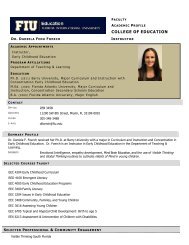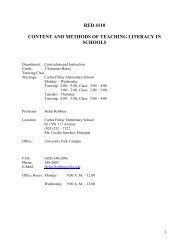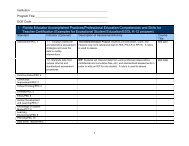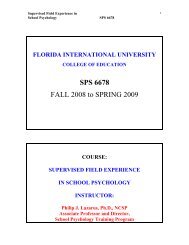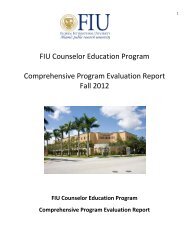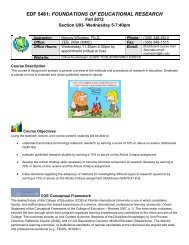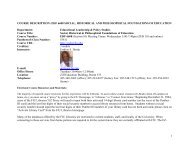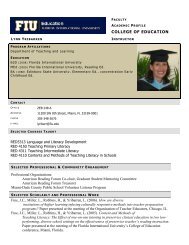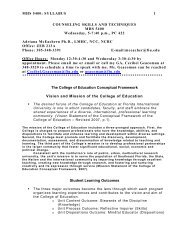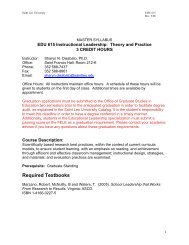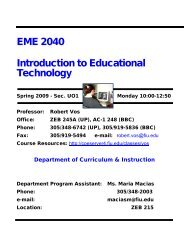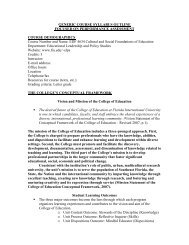RED 4325 RED 5339 Just Read Florida! Matrix Competency 1 ...
RED 4325 RED 5339 Just Read Florida! Matrix Competency 1 ...
RED 4325 RED 5339 Just Read Florida! Matrix Competency 1 ...
Create successful ePaper yourself
Turn your PDF publications into a flip-book with our unique Google optimized e-Paper software.
<strong>RED</strong> <strong>4325</strong><br />
<strong>RED</strong> <strong>5339</strong><br />
<strong>Just</strong> <strong>Read</strong> <strong>Florida</strong>! <strong>Matrix</strong><br />
<strong>Competency</strong> 1: Foundations in Language & Cognition<br />
Has substantive knowledge of language structure and function and cognition for each of the five major components of the reading<br />
process.<br />
Indicator<br />
code<br />
Specific Indicator<br />
Curriculum Study<br />
Assignment(s)<br />
1.A.1<br />
Specific Indicator A: Phonemic Awareness<br />
• Identify and apply basic concepts of phonology as they relate to<br />
language development and reading performance (e.g., phonological<br />
process, inventory of phonemes, phonemic awareness skills, phonemic<br />
analysis)<br />
1.A.2 • Distinguish both phonological and phonemic differences in language<br />
and their applications in written and oral discourse patterns (e.g.,<br />
language & dialect differences)<br />
1.B.1<br />
Specific Indicator B: Phonics<br />
• Identify structural patterns of words as they relate to reading<br />
development and reading performance (e.g., inventory of orthographic<br />
representations, syllable conventions; spellings of prefixes, root words,<br />
affixes)<br />
1.B.2 • Apply structural analysis to words (e.g., orthographic analysis, spelling<br />
morphologies, advance phonics skills)<br />
• Title: List-Group- Label lesson plan and Reflection<br />
• Purpose: To identify and apply basic concepts of phonology<br />
as they relate to language development and reading<br />
performance<br />
• Assessment: Rubric<br />
• Title: List-Group- Label lesson plan and Reflection<br />
• Purpose: To distinguish both phonological and phonemic<br />
differences in language and their applications in written and<br />
oral discourse patterns<br />
• Assessment: Rubric<br />
• Title: List-Group- Label lesson plan and Reflection<br />
• Purpose: To identify structural patterns of words as they<br />
relate to reading development and reading performance<br />
• Assessment: Rubric<br />
• Title: List-Group- Label lesson plan and Reflection<br />
• Purpose: To apply structural analysis to words<br />
• Assessment: Rubric
1.C.1<br />
Specific Indicator C: Fluency<br />
• Identify the principles of reading fluency as they relate to reading<br />
development<br />
• Title: List-Group- Label lesson plan and Reflection<br />
• Purpose: To identify the principles of reading fluency as<br />
they relate to reading development<br />
• Assessment: Rubric<br />
1.C.2 • Understands the role of reading fluency in development of the reading<br />
process<br />
1.D.1<br />
Specific Indicator D: Vocabulary<br />
• Identify and apply principles of English morphology as they relate to<br />
language acquisition (e.g., identify meanings of morphemes,<br />
inflectional and derivational morphemes, morphemic analysis)<br />
• Title: List-Group- Label lesson plan and Reflection<br />
• Purpose: To understand the role of reading fluency in<br />
development of the reading process<br />
• Assessment: Rubric<br />
• Title: List-Group- Label lesson plan and Reflection<br />
• Purpose: To identify and apply principles of English<br />
morphology as they relate to language acquisition<br />
• Assessment: Rubric<br />
1.D.2 • Identify principles of semantics as they relate to vocabulary<br />
development (e.g., antonyms, synonyms, figurative language, etc.)<br />
1. E. 1 Specific Indicator E: Comprehension<br />
• Identify principles of syntactic function as they relate to language<br />
acquisition and reading development (e.g., phrase structure, types of<br />
sentences, sentence manipulations)<br />
1. E. 2 • Understands the impact of variations in written language of different<br />
text structures on the construction of meaning<br />
1. E. 3 • Identify cognitive task levels and the role of cognitive development in<br />
the construction of meaning of a variety of texts (e.g., knowledge,<br />
comprehension, application, analysis, synthesis, evaluation)<br />
• Title: List-Group- Label lesson plan and Reflection<br />
• Purpose: To identify principles of semantics as they relate<br />
to vocabulary development<br />
• Assessment: Rubric<br />
• Title: List-Group- Label lesson plan and Reflection<br />
• Purpose: To identify principles of syntactic function as they<br />
relate to language acquisition and reading development<br />
• Assessment: Rubric<br />
• Title: List-Group- Label lesson plan and Reflection<br />
• Purpose: To understand the impact of variations in written<br />
language of different text structures on the construction of<br />
meaning<br />
• Assessment: Rubric<br />
• Title: List-Group- Label lesson plan and Reflection<br />
• Purpose: To identify cognitive task levels and the role of<br />
cognitive development in the construction of meaning of a<br />
variety of texts<br />
• Assessment: Rubric
1. E. 4 • Understands the transactive nature of the reading process in<br />
constructing meaning from a wide variety of texts and for a variety of<br />
purposes (e.g., text connections: within texts, across texts, from text to<br />
self, from text to world)<br />
1.F.1<br />
Specific Indicator F: Integration of the major reading components<br />
• Identify language characteristics related to informal language and<br />
cognitive academic language.<br />
1.F.2 • Identify phonemic, semantic, and syntactic variability between English<br />
and other languages.<br />
1.F.3 • Understands the interdependence between each of the major reading<br />
components and their effect upon fluency in the reading process (e.g.,<br />
reading rate, phonological processing and construction of meaning)<br />
1.F.4 • Understands the interdependence between each of the major reading<br />
components and their affect upon comprehension (e.g., construction of<br />
meaning: vocabulary, fluency)<br />
1.F.5 • Understands the impact of dialogue, writing to learn, and print<br />
environment upon reading development<br />
• Title: List-Group- Label lesson plan and Reflection<br />
• Purpose: To understand the transactive nature of the reading<br />
process in constructing meaning from a wide variety of<br />
texts and for a variety of purposes<br />
• Assessment: Rubric<br />
• Title: List-Group- Label lesson plan and Reflection<br />
• Purpose: To identify and apply basic concepts of phonology<br />
as they relate to language development and reading<br />
performance<br />
• Assessment: Rubric<br />
• Title: List-Group- Label lesson plan and Reflection<br />
• Purpose: To identify phonemic, semantic, and syntactic<br />
variability between English and other languages<br />
• Assessment: Rubric<br />
• Title: List-Group- Label lesson plan and Reflection<br />
• Purpose: To understand the interdependence between each<br />
of the major reading components and their effect upon<br />
fluency in the reading process<br />
• Assessment: Rubric<br />
• Title: List-Group- Label lesson plan and Reflection<br />
• Purpose: To understand the interdependence between each<br />
of the major reading components and their affect upon<br />
comprehension<br />
• Assessment: Rubric<br />
• Title: List-Group- Label lesson plan and Reflection<br />
• Purpose: To understand the impact of dialogue, writing to<br />
learn, and print environment upon reading development<br />
• Assessment: Rubric
COMPETENCY 2: Foundations of Research-Based Practices<br />
Understands the principles of scientifically based reading research as the foundation of comprehensive instruction that<br />
synchronizes and scaffolds each of the major components of the reading process toward student mastery.<br />
Indicator code Specific Indicator Curriculum Study<br />
Assignment<br />
2.A Specific Indicator A: Phonemic Awareness<br />
• Identify explicit, systematic instructional plans for<br />
scaffolding development of phonemic analysis of the<br />
sounds of words (e.g., phonemic blending, segmentation,<br />
etc.)<br />
2.B Specific Indicator B: Phonics<br />
• Identify explicit, systematic instructional plans for<br />
scaffolding development from emergent through<br />
advanced phonics with words from both informal and<br />
academic language (e.g., orthographic skills, phonetic<br />
and structural analysis: rules, patterns, and<br />
generalizations)<br />
2.C Specific Indicator C: Fluency<br />
• Identify explicit, systematic instructional plans for<br />
scaffolding fluency development and reading endurance<br />
(e.g., rereading, self-timing, independent reading material,<br />
reader’s theater, etc.)<br />
2.D Specific Indicator D: Vocabulary<br />
• Identify explicit, systematic instructional plans for<br />
scaffolding vocabulary and concept development (e.g.,<br />
common morphological roots, morphemic analysis,<br />
system of word relationships, semantic mapping,<br />
semantic analysis, analogies, etc.)<br />
2.E Specific Indicator E: Comprehension<br />
• Identify explicit, systematic instructional plans for<br />
• Title: Differentiated lesson plan based on<br />
student’s level of reading and Reflection<br />
• Purpose: To identify explicit, systematic<br />
instructional plans for scaffolding development of<br />
phonemic analysis of the sounds of words<br />
• Assessment: Rubric<br />
• Title: Differentiated lesson plan based on<br />
student’s level of reading and Reflection<br />
• Purpose: To identify explicit, systematic<br />
instructional plans for scaffolding development<br />
from emergent through advanced phonics with<br />
words from both informal and academic language<br />
• Assessment: Rubric<br />
• Title: Differentiated lesson plan based on<br />
student’s level of reading and Reflection<br />
• Purpose: To identify explicit, systematic<br />
instructional plans for scaffolding fluency<br />
development and reading endurance<br />
• Assessment: Rubric<br />
• Title: Differentiated lesson plan based on<br />
student’s level of reading and Reflection<br />
• Purpose: To identify explicit, systematic<br />
instructional plans for scaffolding vocabulary and<br />
concept development<br />
• Assessment: Rubric<br />
• Title: Differentiated lesson plan based on<br />
student’s level of reading and Reflection
2.F.1<br />
2.F.2<br />
2.F.3<br />
scaffolding development of comprehension skills and<br />
cognition (e.g., key questioning strategies such as<br />
reciprocal teaching, analysis of relevance of details,<br />
prediction; “think-aloud” strategies, sentence<br />
manipulation, paraphrasing, etc.)<br />
Specific Indicator F: Integration of the major reading components<br />
• Identify comprehensive instructional plans that<br />
synchronize the major reading components (e.g., a<br />
lesson plan: structural analysis, morphemic analysis,<br />
reciprocal teaching, rereading, etc.)<br />
• Identify explicit, systematic instructional plan for<br />
scaffolding content area vocabulary development and<br />
reading skills (e.g., morphemic analysis, semantic<br />
analysis, reciprocal teaching, writing to learn, etc.)<br />
• Identify resources and research-based practices that<br />
create both language-rich and print-rich environments<br />
(e.g., large and diverse classroom libraries; questioning<br />
the author; interactive response to authentic reading and<br />
writing tasks, etc.)<br />
2.F.4 • Identify research-based guidelines and selection tools for<br />
choosing literature and expository text appropriate to<br />
students’ interests and independent reading proficiency<br />
• Purpose: To identify explicit, systematic<br />
instructional plans for scaffolding development of<br />
comprehension skills and cognition<br />
• Assessment: Rubric<br />
• Title: Differentiated lesson plan based on<br />
student’s level of reading and Reflection<br />
• Purpose: To identify comprehensive instructional<br />
plans that synchronize the major reading<br />
component synchronize the major reading<br />
components<br />
• Assessment: Rubric<br />
• Title: Differentiated lesson plan based on<br />
student’s level of reading and Reflection<br />
• Purpose: To identify explicit, systematic<br />
instructional plan for scaffolding content area<br />
vocabulary development and reading skills<br />
• Assessment: Rubric<br />
• Title: Differentiated lesson plan based on<br />
student’s level of reading and Reflection<br />
• Purpose: To identify resources and research-based<br />
practices that create both language-rich and printrich<br />
environments<br />
• Assessment: Rubric<br />
• Title: Differentiated lesson plan based on<br />
student’s level of reading and Reflection<br />
• Purpose: To identify research-based guidelines<br />
and selection tools for choosing literature and<br />
expository text appropriate to students’ interests<br />
and independent reading proficiency<br />
• Assessment: Rubric



